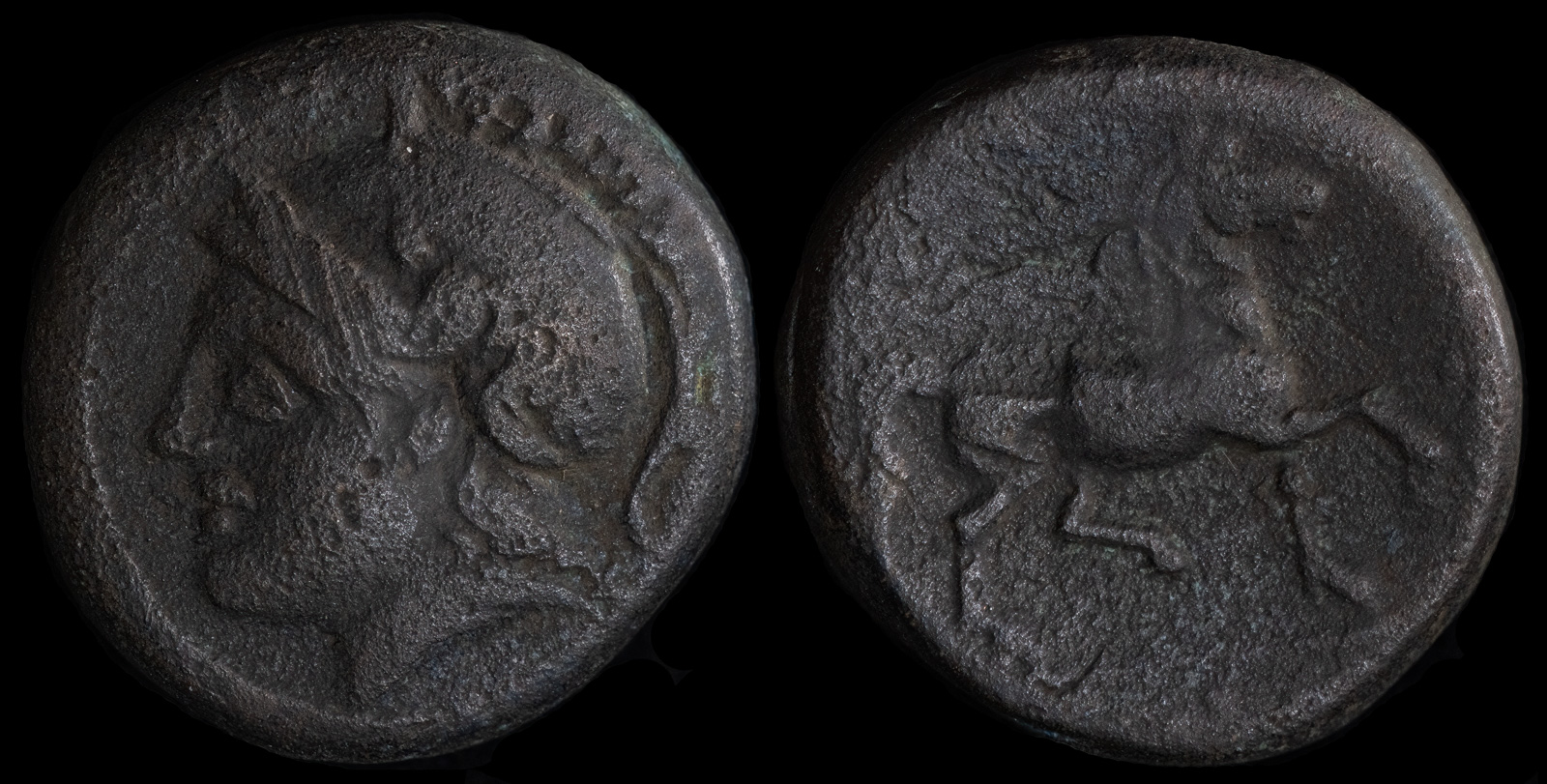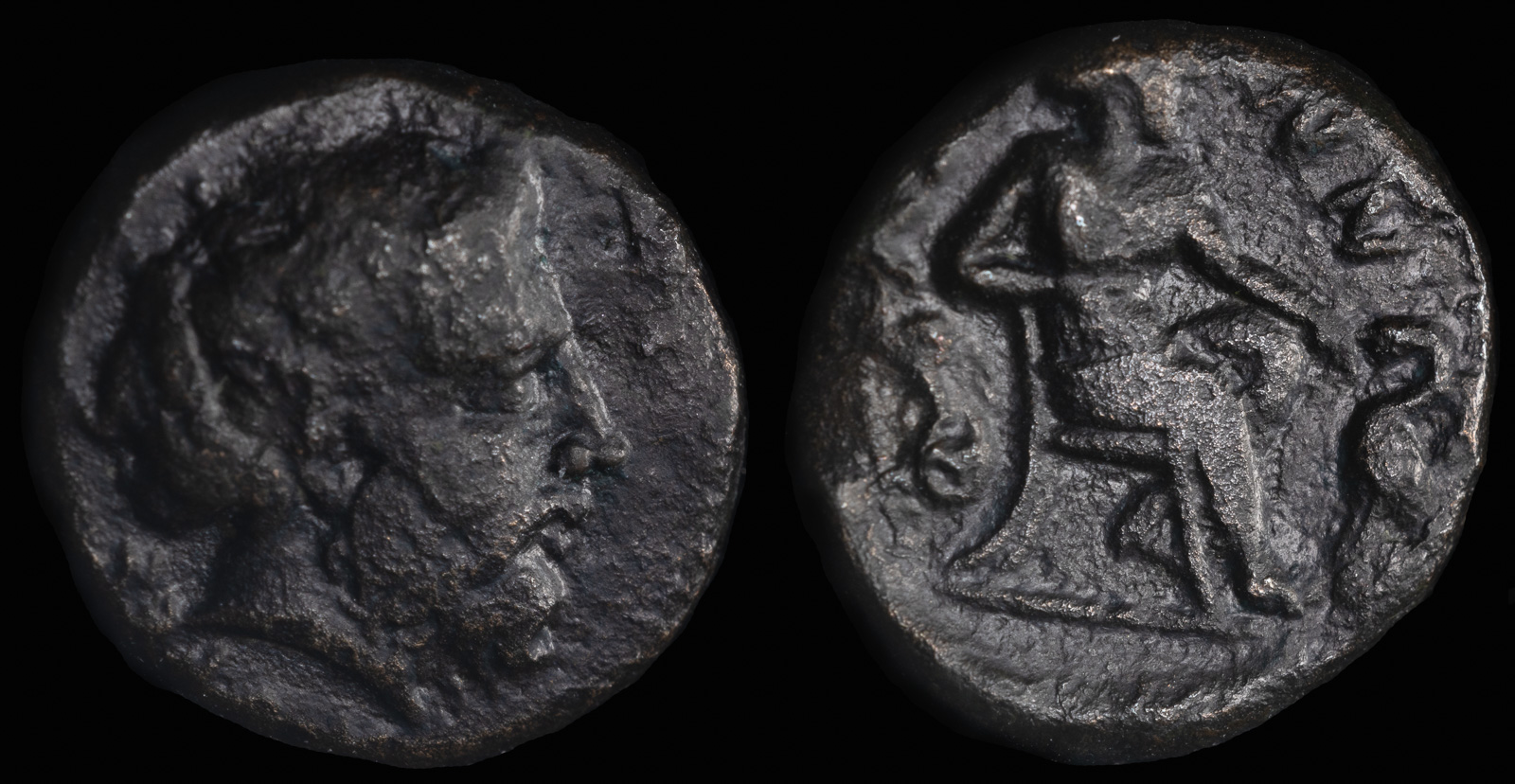
Thessaly. Phalanna
circa 325-300 BCE
Æ 15 mm, 4,60 g
Helmeted head of Ares left
ΦΑΛΑNNΑΙΩΝ, horse prancing right
Papaevangelou-Genakos 10; Rogers –; BCD Thessaly I 1257; BCD Thessaly II 576; HGC 4, 172
Phalanna was a city of the Perrhaboi and may solve my question of why the Perhhaboi had so few coins despite being so powerful. Perhaps that coinage was also minted in Phalanna, or perhaps the Perrhaboi coinage was intended to be more regional.
Regardless, the coinage of Phalanna is vast and varied. There are some collectors who strive to gather all the possible variants, but in truth no one has been able to order it within any sense. While there are some issues labeled as belonging to certain battles and moments, the truth is we can only guess at exact dates so instead the coinage must be given date ranges.
To me, the issues of Phalanna are among the most fascinating of ancient Greece, and in the future I hope to add more. What makes it even more peculiar is that the city isn’t oftened mentioned in ancient sources.

Thessaly, Phalanna
circa 350 BCE
AE 2.63g 14mm
Obv: Laureate head of Apollo to right.
Rev: ΦΑΛΑΝ Head of nymph right, with hair in sakkos.
BCD Thessaly II 575.2.
Ex Nomos
Strabo suggests the possibility that Orthe was the acropolis of Phalanna, though most scholars today consider them different cities.
Per legend, the city received its name from a daughter of Tyro, who was a princess of Elis.

Thessaly, Phalanna
circa 400-250 BCE
Æ 18mm, 6,52g
Young head of male (Ares?) right /
Head of nymph right, hair in sakkos, within incuse circle.

Phalanna, Thessaly
Mid-late 4th century BCE
Ae Chalkous 14.8mm, 4.4gms
Obv: PELORES; head of Zeus Peloris right
Rev: FALLA-NN; The nymph Phalanna seated right on chair, feeding stork to right
BCD Thessaly II 574
Ex-BCD Collection
The coinage of Phalanna is not rare, and is actually perhaps the most common Thessalian city, which is all the more odd because as far as we can tell it was a pipsqueak of a town. A few ancient sources mentioned it, so we know it existed, but it was far from being a power even in Thessaly. However, it issued a tremendous number of types. There is some speculation that it was a common coinage across northern Thessaly, given its vast coinage. However, what made me pickup this example was the reverse.
Per the agreed-upon attribution, it depicts the nymph Phalanna, sitting on a chair, feeding a stork. One thing I’ve learned about Greek coinage is everything on these coins was deliberate. The engraver didn’t just happen to have a thing for storks and so engraved a woman feeding one. There was a story behind this.
I want to know the story. So, my first question was: who was Phalanna?
Phalanna was the daughter of Tyro, who in turn was the daughter of King Salmonaios of Elis and Alkidike, daughter of King Alaios of Arkadia. Tyro’s descendants numbered among the major players in ancient Greece, such as Aison, the father of Jason, who headed up the Argonauts and who unfortunately pissed off Medea. Tyro was an interesting woman, but we’re most curious about Phalanna, and about her we know nothing other than we assume she founded Phalanna or had a major part in it, since the city was named after her.
So, we now come to the stork. Since I couldn’t find any stories about Phalanna and a stork (or a heron or crane), I turned to the literature. Back then, there was no such thing as copyright-infringement, so cities commonly stole each other’s stories. Many are claimed by multiple cities, so I looked there.
Indeed, storks are well attested in ancient literature, far more than cranes and herons.
My first destination was Artemidoros, to see how people dreamed of storks.
“Cranes and storks seen congregating inf locks signify attacks by brigands or enemies. If they appear in a dream in winter, they bring on a storm, and if in summer, a drought. Seen in isolation and singly, cranes and storks are auspicious for travel abroad and return from travel, since these birds set off on their own travels and migrate at the turn of the seasons. And they are auspicious also for marriage and the procreation of children, because they produce their young from a monogamous union: storks are particularly apposite for the procreation of children because of the care that the offspring take of their parents.”
I found this interesting – and I definitely recommend a read of Artemidoros in general – so I moved on to Aristotle, who had a thing for critters.
“It is a common story of the stork that the old birds are fed by their grateful progeny.”
So, not much more than what Artemidoros reported. After finding nothing in Pliny, I turned to Aelian, perhaps the best ancient source on animals. There, I learned a lot about storks.
“Storks have a very clever device for warding off the bats that would damage their eggs: one touch from the bats turns them to wind-eggs and makes them infertile. Accordingly, this is the remedy they use to prevent this happening. They lay the leaves of a plane-tree upon their nests, and directly the bats come near the storks, they are benumbed and become incapable of doing harm.”
“When their parents have grown old, Storks tend them voluntarily and with studied care; yet there is no law of man that bids them do so; the cause of their actions is Nature. And the same birds love their offspring too. Here is the proof: when the full-grown bird is in want of food to give to its still un fledged and tender chicks, some accident having occasioned a shortage, the Stork disgorges its food of yesterday and feeds its young. And I am told that Herons do the same, and Pelicans also.
I learn further that Storks migrate along with Cranes and all together avoid the winter. But when the season of frost is over and both Storks and Cranes return to their own homes, each kind recognises its own nests, as men do their own houses.
Alexander of Myndus asserts that when they reach old age they pass to the islands of Ocean and are transformed into human shape, and that this is a reward for their filial piety towards their parents, since, if I am not mistaken, the gods especially desire to hold up there if nowhere else a human model of piety and uprightness, for in no other country under the sun could such a race continue to exist.”
“They say that the Stork also is subject to jealousy. At any rate at Crannon in Thessaly a man who had married a beautiful wife of the name of Alcinoe left her at home and went away on his travels. So Alcinoe had intercourse with one of the servants. The Stork that was about the house got to know of this and would not tolerate it, but avenged its master. At any rate it sprang upon the woman and blinded her eyes.”
Those I just found interesting, but this story may have some relevance.
“There was a woman in Tarentum, admirable in other ways and particularly as a faithful wife. Her name was Heracleis.
So long as her husband lived she cared for him with the utmost devotion. But when he died the woman took a dislike to life in the city and to the home in which she had seen her husband dead, and such was her grief that she went to dwell among the tombs and was content to remain by her late husband’s sepulchre, constant to him who was beneath the soil. And once in summer when some storks, still fledglings, were essaying their first flight, one of them, the youngest, not having sufficient strength of wing, fell and broke one of its legs. So Heracleis seeing its fall and finding how its leg was injured, took pity on the nestling and picking it up very gently wrapped up the wound, and tended it with fomentations and plasters, brought it food, gave it drink, and, when in due course it was strong and had grown its quill-feathers, set it free. And the stork, knowing by some strange instinct that it owed her the price of its life, departed. Later when a year had passed and spring was just beginning to brighten, the woman chanced to be warming herself in the sun, and the Stork which had been healed by her, seeing its benefactress, checked the speed of its wings and sinking nearer to earth came close, opened its bill, and disgorged a stone into the lap of Heracleis, and then flew off and settled on the roof. At first, naturally enough, she was amazed and startled out of her wits, and was at a loss to conjecture what this action could mean. And so she put the stone away somewhere indoors; later being woken in the night she saw that it diffused a brightness and a gleam, and the house was lit up as though a torch had been brought in, so strong a radiance came from, and was engendered by, the lump of stone. And when she had taken hold of the Stork and handled it she recognised the scar left by the wound, and knew that it was the very bird which had been the object of her pity and her ministrations.”
Based on the fact the woman is seated on the chair, could she be old at this point? Perhaps she’s not feeding the stork, but instead it’s giving her something? Maybe it’s some artifact that was important to the city? Or maybe it was as the story mentions, a stone, and in typical ancient Greek fashion this stone was kept in a temple for others to see.
We can’t really test this theory at all, since from my understand we aren’t entirely sure where exactly the city was, and thus we have no ruins to excavate. Pausanias never wrote about it and Strabo only briefly. But, for now it’s the closest I can come up with.
Perseus of Macedon fortifies Gonnos and travels through Phalanna.